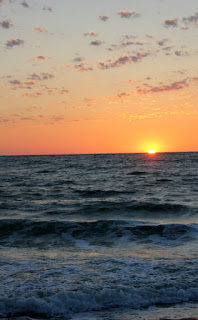When last we left our heroines, they were meandering through the Everglades…
We rejoin them as make their way to their final destination,
Key West.
We hoped to see some Key deer on our trip, but when we
arrived in Big Pine Key, the National Key Deer Refuge was closed for the day.
Luckily for us, the Blue Hole (an abandoned rock quarry filled with water—the only fresh water lake in the
Keys), which is part of the refuge, was
accessible from the roadside. Jackpot! As soon as we got out of the car, we saw
a Key deer foraging along the path. Eventually, she was joined by two others.
Obligingly, they kept close to the paths and we were able to quietly follow
them around snapping photos.
The Key deer, which is endangered, is the smallest
subspecies of the North American white-tailed deer. It measures between 24 and
32 inches at the shoulder, and weighs between 45 and 80 pounds. Seventy-five percent of Key deer live on No
Name Key and Big Pine Key, according to the National Key Deer Refuge website.
The refuge was established on Big Pine Key in 1957. (To learn more about Key deer, click here or here.)
What lovely little creatures they are:
After leaving the deer behind, we arrived in Key West just in time to park and
watch the sunset…right next door to Mallory Square:
The next morning, we packed our one full day in Key West with walking, eating,
and taking pictures. We’re wild like that.
Ernest Hemingway’s house:
 |
| Side view |
 |
| Writing room |
One of the Hemingway house cats holding court:
The Key West lighthouse:
One of the best things I’ve ever eaten—a goat cheese and walnut crepe, at Banana Cafe:
And then, oh then, the best destination of all: The Key West Butterfly and Nature Conservancy. We both lost our minds a little bit in this
tiny gem of a place, between the butterflies flitting everywhere, the button
quail at our feet, the flamingos flapping and calling (mating season), and the
bright birds high in the trees. We stayed for at least two and a half hours,
until they threw us out at closing time, in fact. If you go to Key West, this
place is well worth a visit. (Two-dollar off discount coupons are readily
available, and the gift shop here is something special, too.) Here are only a
few of the photos I took:
 |
 |
After we staggered out of the Butterfly Conservancy, we wandered to the Southernmost Point
marker:
and then all the way back to Mallory Square for dinner and one
last sunset:
 |
| Shot with my phone after my camera battery died! |
The next morning, we packed up and drove home. And that, my
friends, brings our road trip saga to a close. I hope you’ve enjoyed this
glimpse of some of the simple pleasures and everyday adventures you can find
while road tripping in Florida. Thanks for letting me relive our adventures as
I shared them with you!































































.jpg)


